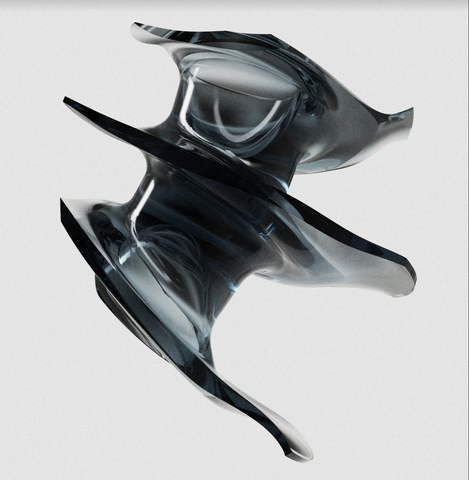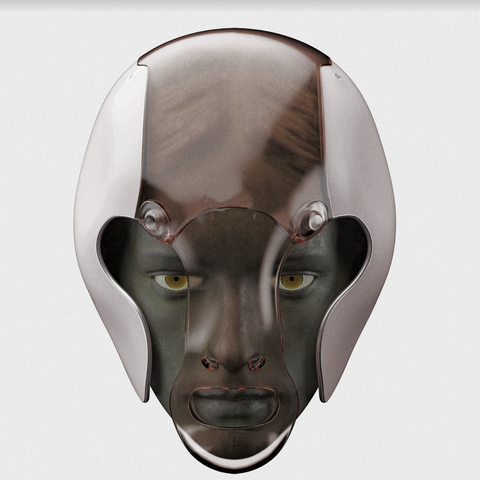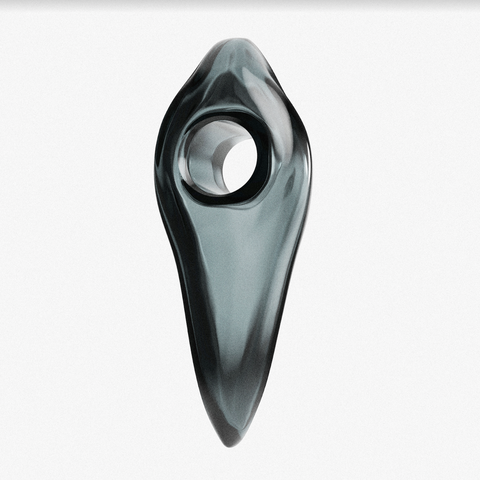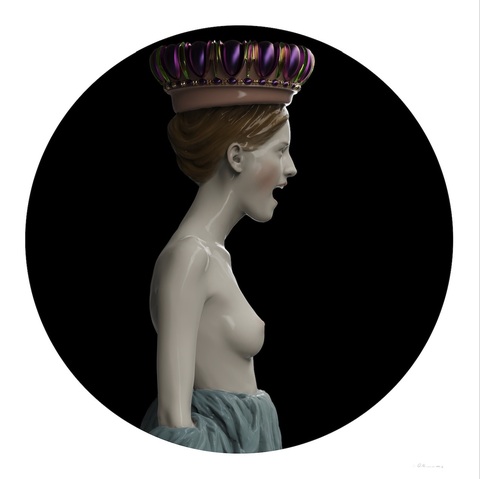EXODUS
Alexey Morozov
EXODUS
Pisa, Italy
July, 21 - September, 30 2024
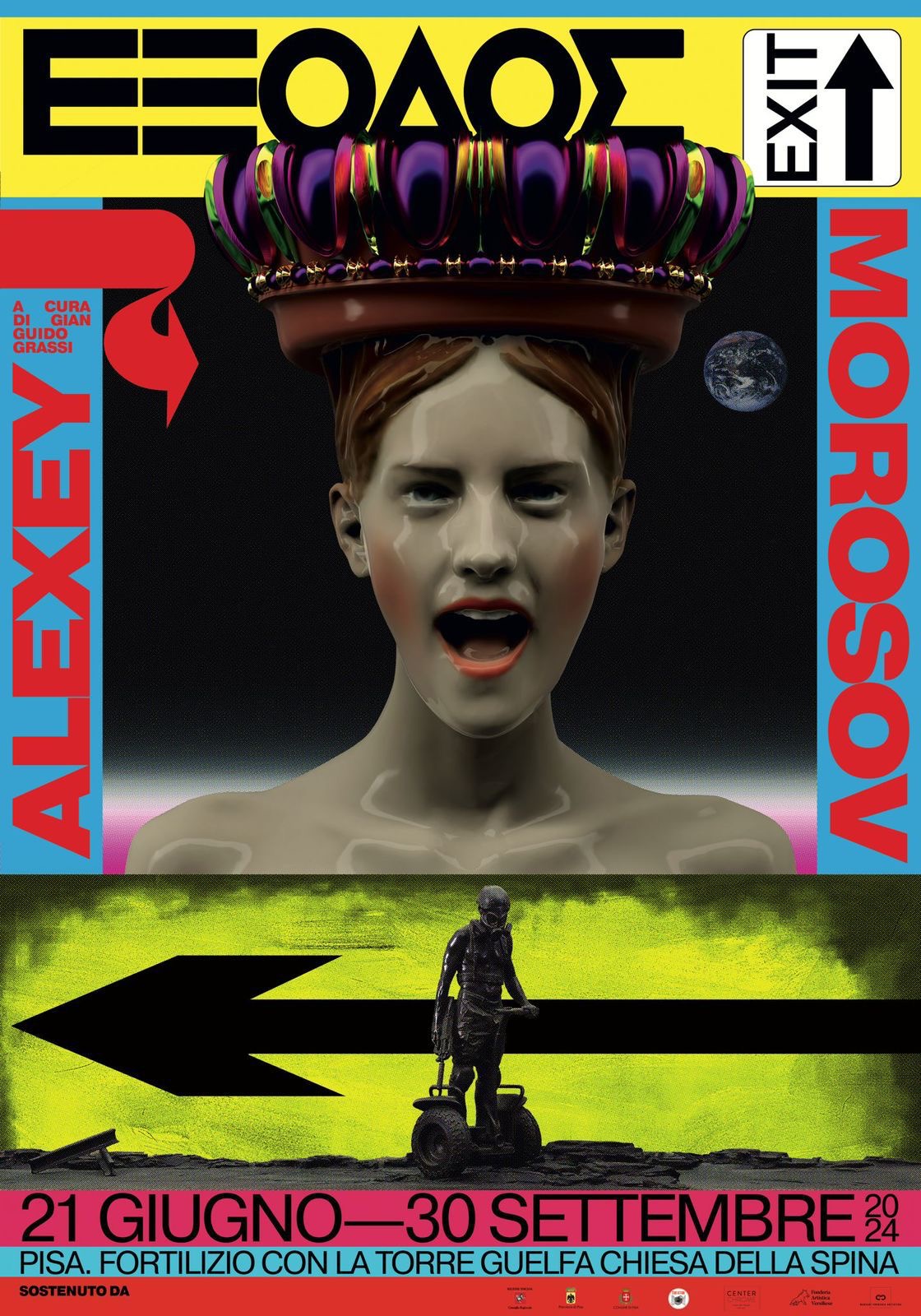
In Pisa, with the support of the City Hall and the Region of Tuscany, an exhibition of Alexei Morozov (resident of a-s-t-r-a gallery) is taking place.
“EXODUS” is the second part of a trilogy the artist is working on.
The first part, “PONTIFEX_MAXIMUS”, was presented at the National Archaeological Museum of Naples and in Moscow, at the MMOMA at 12 Gogolevsky Boulevard in 2016-2017.
Now Morozov is unfolding another epic canvas in the form of a network site-specific installation in the historical geography of Pisa.
The ancient city appears as a sacred space on which a “network of meanings and statements” is cast. The intrusions of artistic objects in the space from Chiesa della Spina and Palazzo Blu to Torre Guelfa and Piazza dei Miracoli invite the viewer to follow the path of the Exodus of modern humanity, recalling archaic forgotten cults, biblical promises, Puccini's musical narratives and Chekhov's prophetic texts. The artist himself, who was born in Central Asia, at the terminus of Alexander the Great's Anabasis, in the mountainous country of Kyrgyzstan, has traveled his life's path in the opposite direction - from the East to Italy (to the midnight sea in the legends of the Turks and Mongols).
Morozov's work, in addition to appealing to Neolithic legends and ancient Greco-Roman iconography, is characterized by virtuoso sculptural and pictorial techniques, close in patterns to Italian and French plastic art of the 16th-17th century.
But first and foremost, the artist is known for his clear and profound conceptual statements, which, together with his masterful visual style, will set him apart in the field of contemporary art.
The project is represented by monumental sculptures and two exhibition areas divided into spaces called “CASA” (*House), according to the principle of alchemical practices: the House of Renewal, the House of the Priest, the House of Birds and the House of the Anatomist.
To see the exposition you have to go along the Lungarno, from Palazzo Comunale to Palazzo Blu and further, through the church of Santa Maria della Spina (a masterpiece of early Gothic architecture, a jewel of the Tuscan architectural heritage of the early XIII century) to the former Fortress of the Guelphs - Torre Guelfa and the last but very important point on the Cathedral Square in front of the Baptistery with a view of the Falling Tower.
The beginning of the tour is in the loggia of the Palazzo Comune of Pisa, where “Pilonus” - the pylon of a cable-stayed bridge made of Corten steel, sprouting bronze porticoes with Caryatids - is installed under vaulted, Renaissance ceilings that form a special “air”. The artist's work in general is characterized by this organic dialogue between technogenic and anatomical plasticity, which makes the sound of his artistic language particularly relevant and contextual. Literally a hundred meters down the Arno, opposite the beautiful Palazzo Blu in Pisa, the second of the four monumental compositions, Morozov's sculpture Caryatid Metaphisical - a nude caryatid (3.5 meters high), frozen in an existential cry, is facing the ancient Arno. Above the capitol (with Ionics in the echinus) is a fragment of the entablature, an architectural element that visually ties the sculpture firmly to the surrounding architecture of the Pisan embankment. The Caryatid as the embodiment of the feminine in the Apollo-Artemis pair occupies an important place in Alexei's work, along with Kouros, the embodiment of Apollo. And it is at the entrance to the chamber space of the Chiesa della Spina temple, to which one has to walk along the embankment for the next 100 meters, that the viewer sees the continuation of the installation in the form of an impressive statue of Kouros_iGneus. The three-meter tall figure rises above the waters of the Arno on a laconic pedestal in the form of a truncated pyramid. In the church, the artist deployed a very pure-sounding installation “Casa Metanoia” consisting of two canvases and four sculptures exhibited on specially designed structures, which fit very organically into the slender, monochrome interior of the church. The viewing is accompanied by a sound composition by Federico De Robertis (the most famous contemporary Italian composer). Alexei and Federico have been collaborating since 2018. For the next part of the exposition, there is a walk along the waterfront to Torre Guelfa-a monument of fortification architecture from the very beginning of the 15th century. On the three levels of the tower, Morozov deployed three installations: Casa Socerdote, Casa degli Ucelli and Casa Anatomica.
To complete the exhibition, go to Pisa's Piazza Cathedral Square (where the falling bell tower is). Opposite the Baptistery, the sculptor has placed the composition ERICIUS, created in 2016 and first presented in the same year in the main hall of the Naples Museum.
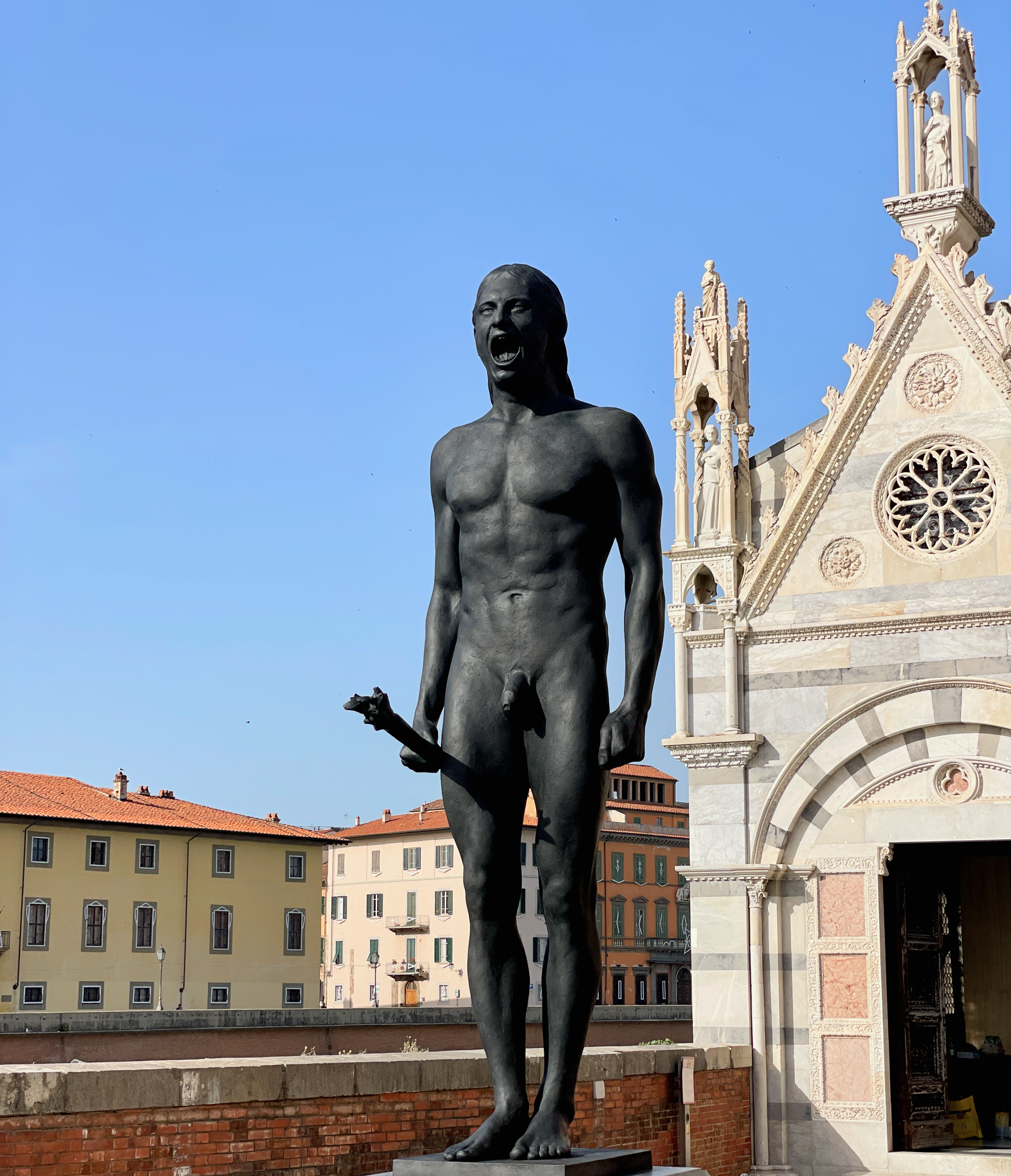
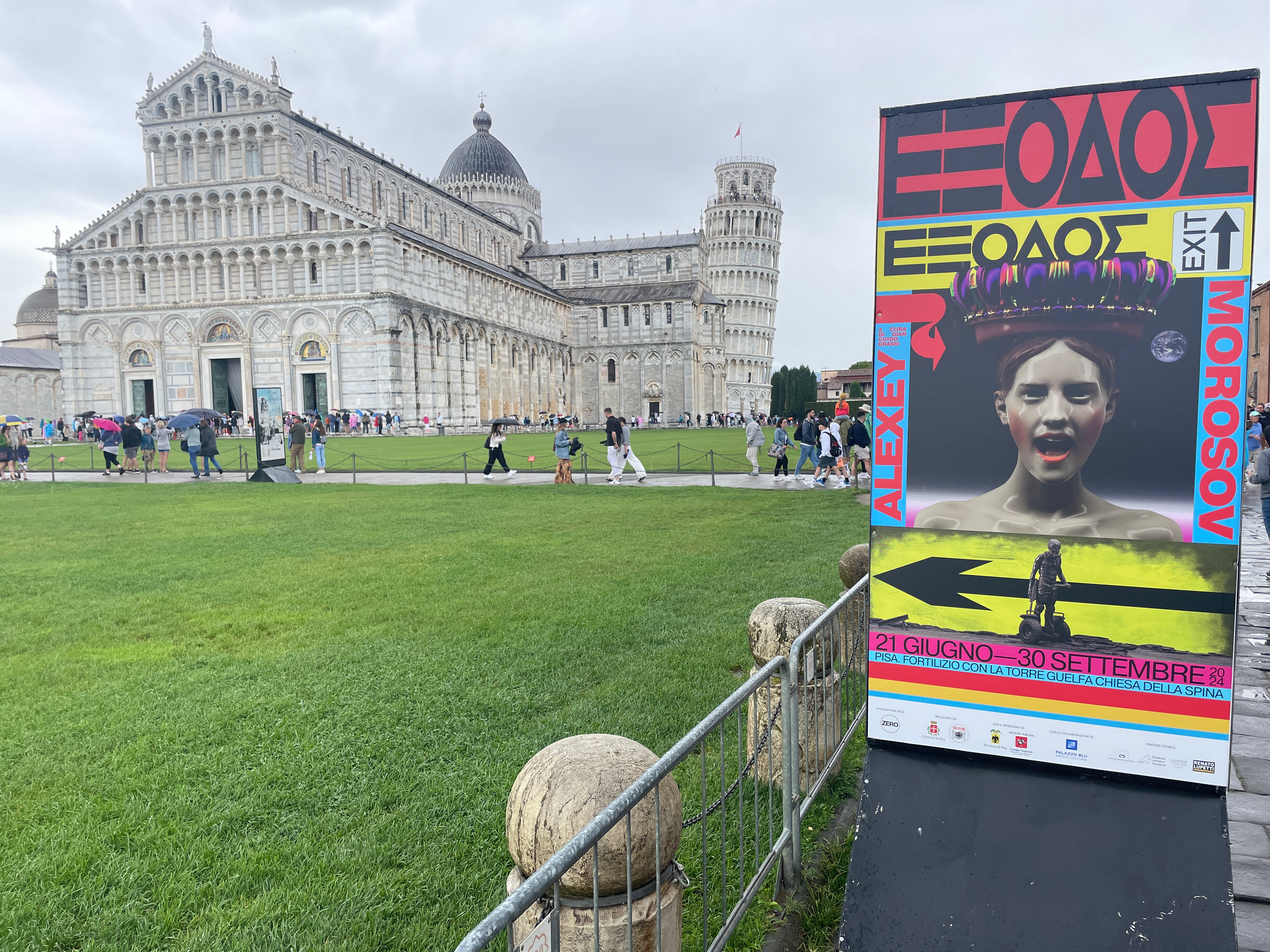
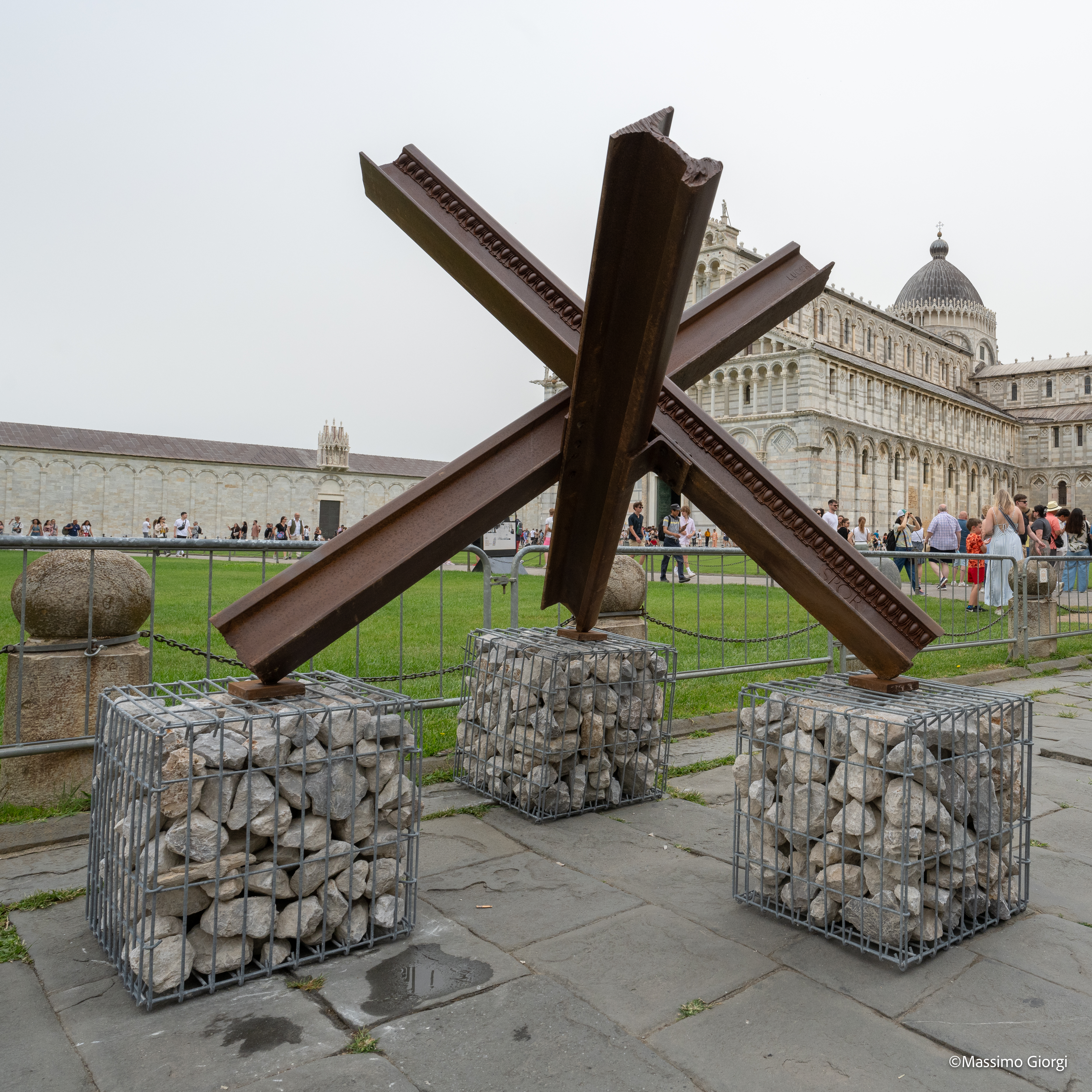
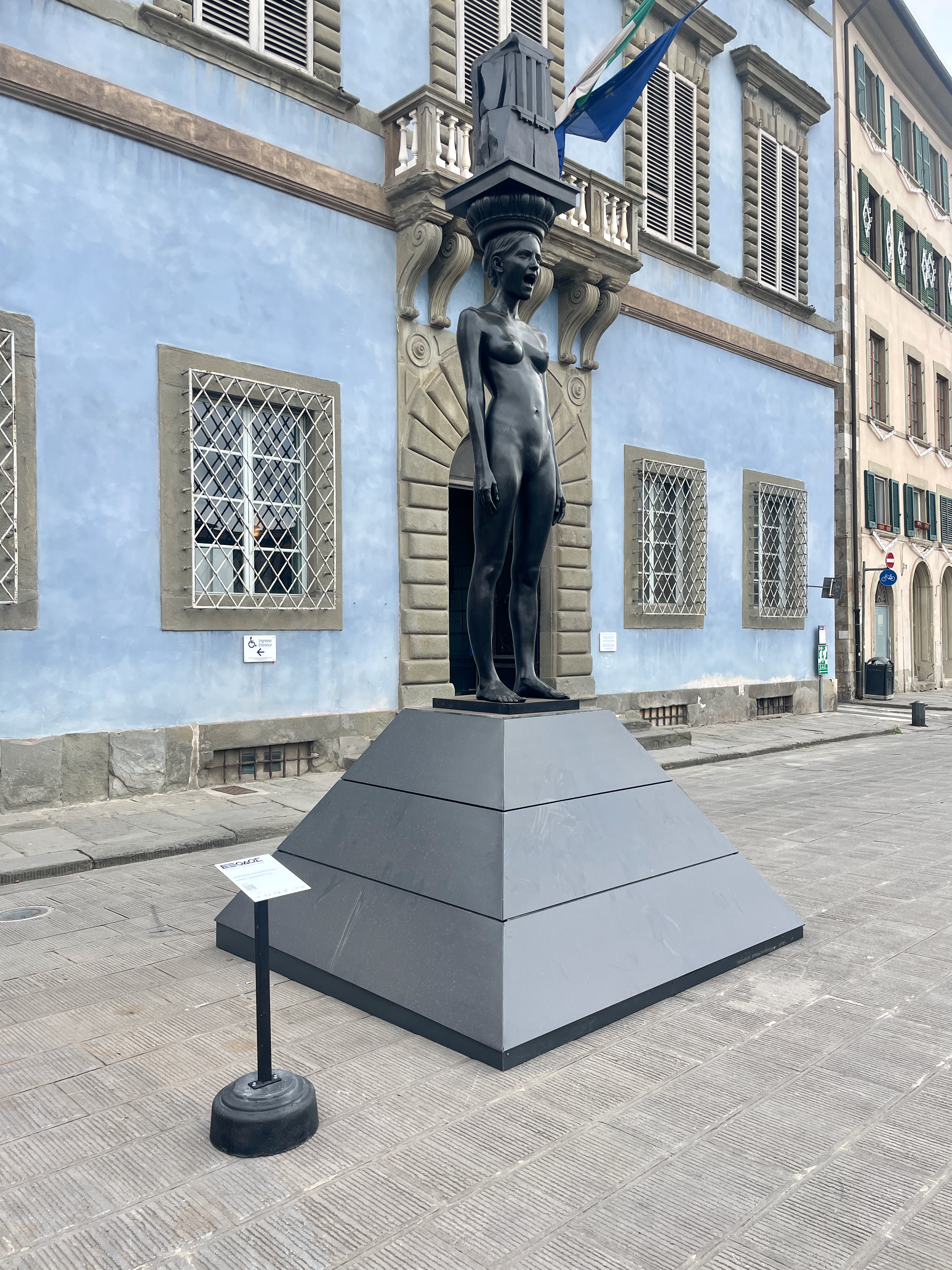
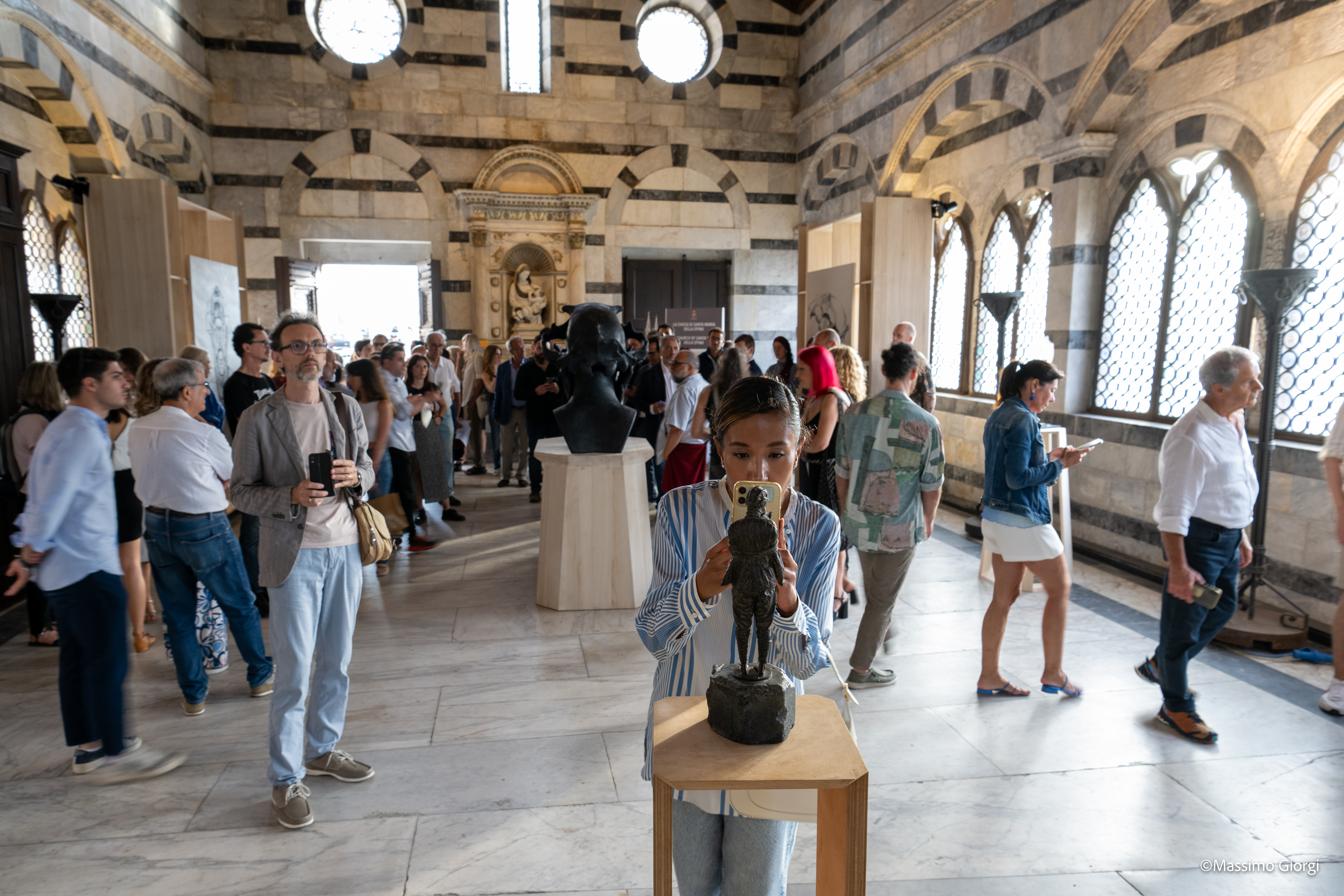
Morozov Alexey
Aleksey Morozov began his artistic career in the early 1990s, taking part in the Second Biennial of Contemporary Art in St. Petersburg, where he won one of the Grand Prix of the exhibition. After graduating from the institute, he spent a year in Provence in 1998, where he studied French sculpture from the 16th-18th centuries and practiced working with terracotta.
Born in 1974.
Sculptor, architect, member of the Russian Academy of Arts.
In 1999 he graduated from the Faculty of Sculpture (workshop of academician L. Kerbel) Moscow State Academy of Arts named after Surikov.
Since 2014, member of the Presidium of the RAKh (Russian Academy of Arts).
Aleksey Morozov began his artistic career in the early 1990s, taking part in the Second Biennial of Contemporary Art in St. Petersburg, where he won one of the Grand Prix of the exhibition. After graduating from the institute, he spent a year in Provence in 1998, where he studied French sculpture from the 16th-18th centuries and practiced working with terracotta.
After his return to Russia, Morozov collaborated for a long time with the founder of the New Academy of Fine Arts, and was a member of the New Serious creative movement, a conservative wing of Neo-Academism. He has held solo exhibitions in St. Petersburg, Moscow and Italy and has participated in international art fairs.
In December 2011 - January 2012, the Marble Palace of the Russian Museum hosted a large solo exhibition of Morozov, entitled Antologia, where the artist presented about 60 works created in the previous 10 years.
In July 2013, Alexey Morozov was appointed director of the Moscow State Academic Art School in Memory of 1905. Under his leadership, the reconstruction and renovation of the school began, a new sculpture department was opened, an anatomy department was created to train specialists in plastic anatomy, and Italian internship programs for students were introduced.
He lives and works in Lucca (Italy).
Alexey Morozov's works are sold at Sotheby's, Christie's and Phillips auctions and are in private and museum collections, such as the State Russian Museum, the Museum of the New Academy of Arts in St. Petersburg, etc.
"Alexey Morozov is the author of the project PONTIFEX_MAXIMVS, shown at the 6th Moscow Biennale of Contemporary Art in 2015. The idea for the project refers back to Raphael's Stanzas of the Vatican, where the master introduced the image of caryatids coming to life, and the frescoes of each room were united by a common plot or character. Animate sculpture is one of the fundamental themes of Alexey Morozov. Throughout his artistic career, Morozov consistently creates a huge art universality, reinterpreting the Greco-Roman classical heritage in the context of modernity. In the artist's opinion, the possibilities of the plastic language of Greek and Roman sculpture, which for so many centuries continued to nourish European civilization, are far from exhausted and can still serve as the basis for creating works with a keenly relevant authorial message. The title PONTIFEX_MAXIMVS - that is, "the great bridge-builder" (from the Latin term pons facere, understood in the esoteric practices of the Romans) verbalizes the idea of restoring the links between antiquity and modernity, the East and the West.
Morozov uses classical iconography, but removes its historical meanings and connotations, giving ideal forms the provocative content of modernity. This is also reflected in the choice of materials: the "classical" ones of bronze and marble, as well as concrete and carbon fiber. The bronze sculptures are made in Pietrasanta, Italy, using techniques based on the ancient tradition of hand craftsmanship. Amidst the kaleidoscope of shifting ethical, moral and aesthetic guidelines of today's world, classical culture and iconography proves to be an important point of reference. In his sculpture, graphics and video, Morozov uses the orderly structure of ancient art to analyze and transcend the chaos of the world. His narrative is transported into a post-apocalyptic, desolate, militaristic space, but offers no unambiguous interpretations or interpretations."
SELECTED EXHIBITION PROJECTS:
- 2024 — Cosmoscow, a—s—t—r—a gallery, Moscow, Russia
- 2024 — EXODUS, Pisa, Italy
- 2024 — St. Petersburg Art Fair “1703”, a—s—t—r—a gallery, Manezh, St. Petersburg, Russia
- 2024 — “Antiquity. Coordinate System”, Zaryadye Media Center, Moscow, Russia
- 2024 — “You are here. Always. Today. The Day After Tomorrow”, Museum of Transport of Moscow, Pavilion 26 ‘Transport of the USSR’, VDNKh, Moscow, Russia
- 2024 — Fair |catalog| April, a—s—t—r—a gallery, Moscow, Russia
- 2023 — Fair |catalog| December, a—s—t—r—a gallery, Moscow, Russia
- 2023 — Cosmoscow, a—s—t—r—a gallery, Moscow, Russia
- 2023 — St. Petersburg Art Fair “1703”, a—s—t—r—a gallery, Manezh, St. Petersburg, Russia
- 2022 — "Art Gardens. Metamorphosis", Arkhangelskoye Estate Museum, Moscow
- 2017 — "PONTIFEX_MAXIMVS/ le stanze", Alexey Morozov Art Project. MMOMA, Moscow
- 2016 — "PONTIFEX_MAXIMVS", Alexey Morozov Art Project. Museo Archeologico Nazionale di Napoli, Naples
- 2015 г. "ANTROPOMAHIA," art project by Alexey Morozov. Istanbul Contemporary, Istanbul
- 2015 — "PONTIFEX_MAXIMVS_preview", Alexey Morozov art project. 6th Moscow Biennale of Contemporary Art. VDNKh, Moscow
- 2015 — "Antropomakhia", Alexey Morozov's art project. Cosmoscow, Moscow
- 2015 — "Cantata_iTunes", Alexey Morozov's art project. Homofarber, CAV, Pietrasanta, Italy
- 2014 — "MOROSOV_MMXIV", Heritage Gallery, Moscow
- 2013 — "ART-STAGE" 11.12 Gallery, Singapore
- 2013 — "KARIATIDA SUPERSONICS" M&O, Paris
- 2013 — "KARIATIDA SUPERSONIKA" Piazza Bra, Verona
- 2012 — "SERENITAS" Art Moscow. Sculpture by Alexey Morozov from private collections, Moscow
- 2011-2012 — "ANTOLOGY" The State Russian Museum, St. Petersburg
- 2010 — "BASILICA" Art Moscow. Triumph Gallery, Moscow
- 2009 — "PRAETORIA X" Art Moscow. Triumph Gallery, Moscow
- 2007 — "MOROZOV MANUFAKTURING" Moscow World Fair of Fine Arts. Manege, Moscow
- 2006 — "ERIHO" Moscow World Art Fair. Manege, Moscow
- 2004 — "CONSTANTINOPOLIS" ARTPLAY, Moscow
- 2003 — "Kraft Deco Classics" Gallery D137, Saint Petersburg
- 2003 — "Kraft Deco Akademik" Novaya Akademia, Saint Petersburg
- 2002 — "MAGOS", Vicenza, Italy.
- 2000 — "MITRA SUPER" together with New Academy. Manege, Moscow.
- 1992 — "II Biennial of Contemporary Art" Okhtinsky Exhibition Hall of Artists Union of St.Petersburg.
"...Alexey Morozov's work is a kind of bridge between traditional (and paradoxically attractive) ideas of sculpture, harmonious and transparent; and modern ideas of sculpture, which are conceptually analytical and polemical in nature..." Alexander Borovsky, art historian, curator, head of the department of contemporary trends, State Russian Museum, St. Petersburg/Russia
"...Integrating it and guiding its transition to modern iconography, not retreating from the hieratic character of historical significance.Integrating it and guiding its transition to modern iconography, not retreating from the hieratic character of historical significance.
Bronze, like other "classical" materials, facilitates this type of experimentation, iconographic "transition" and integration between manual labor and technological intervention.
Morozov, as already mentioned, imposes a syncretic strategy also applied to the use of materials, combining "classical" media with technological materials of an industrial nature, as evidenced by the works on display..." Alessandro Romanini, art historian, president of the scientific committee of the Ragianti Lucca Foundation/Italy
"...Alexey Morozov addresses numerous and varied traditions, combining linguistic and iconographic sources - maintaining a balance between coupling and irony and insinuating bold and unexpected 'distractions' - with intensities, signs and themes of a distinctly contemporary nature, while forcing us to reflect on the need, repeatedly manifested throughout history, to choose past models and express ourselves..." Paolo Giulerini, Curator, Director of the National Archaeological Museum of Naples, Naples/Italy)
ABOUT THE APPROPRIATION PROJECT:
A cycle of three series of works from the EXODUS project:
1. METOPE - painting
2. HDV (heavy duty vehicle)- sculpture. 3. Nuovo Marmo (new marble)
3. Nuovo Marmo (new marble)
The APPROPRIATION project is the artist's reflection on the borrowing through metaphysical substitution of aesthetic and ethical categories occurring in contemporary society. The pragmatic “Modus Operandi” of the actual civilization leaves no room for stylization and reflection in the cultural discourse. The laws of global marketing and the concept of sustainable development fundamentally affect the perception of visual images by the viewer of the early XXI century.
The Doric order's metopes are not Polaroid cards? Or the yellow panel of a quarry truck, executed in the tradition of Hellenistic plastic art? And the marble of the Carrara quarries mimic vinyl and silicone. All this has an undeniable right to exist in the world of the “maxim” of pragmatism.
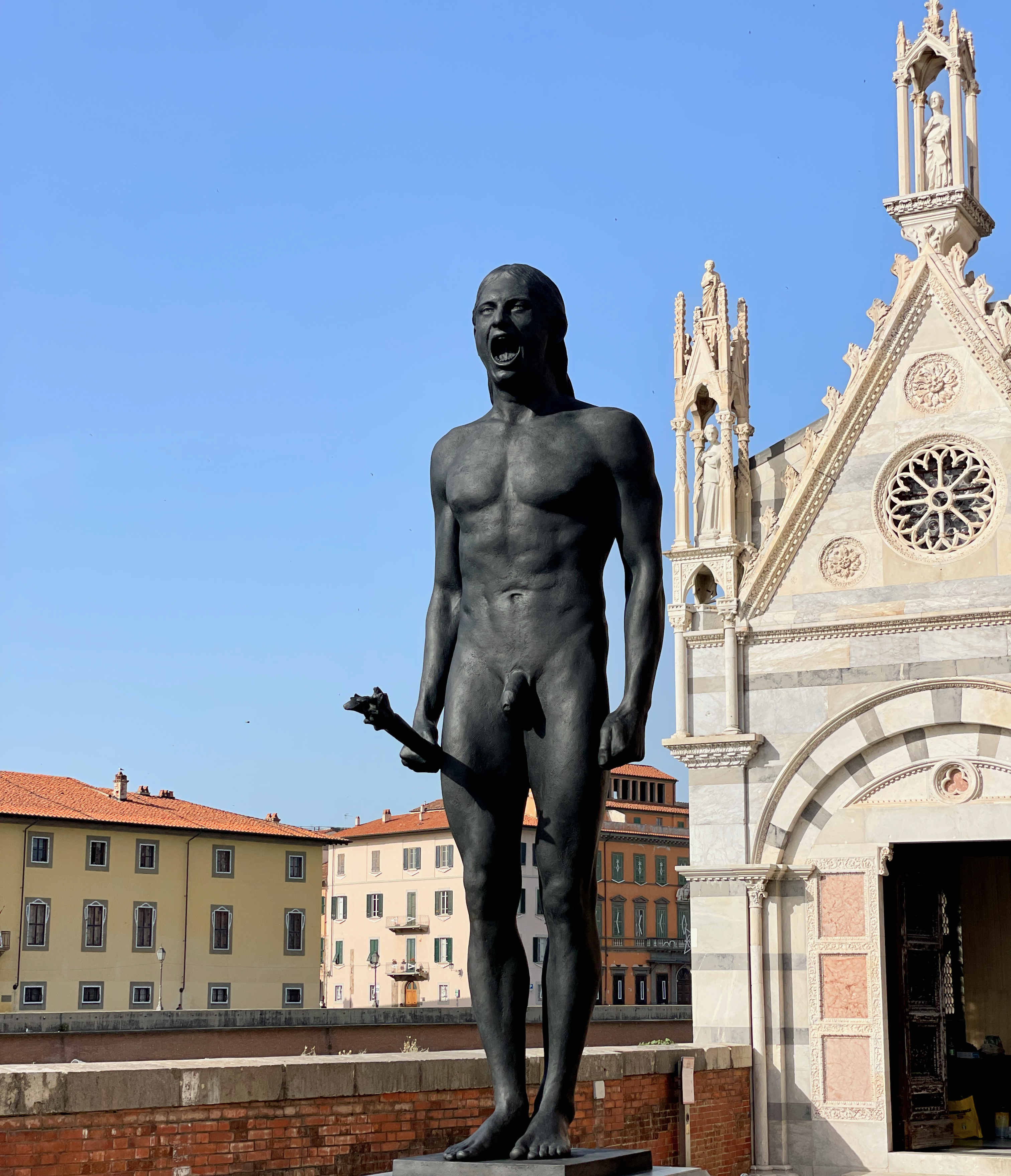
EXODUS exhibition, Pisa, Italy, 2024

